- What is an email calendar?
- Importance of a content calendar
- How to use a calendar
- 1. Recognize crucial dates
- 2. Choose a date and time to send
- 3. Objective of the campaign
- 4.Group of people you want to reach
- 5. Responsibility among team member
- 6. subject line and preheader
- 7. Project Progress
- 8. conduct the multivariate testing
- 9. Checklist for delivery of emails
- 10. Examine the outcomes.
- Start!
Would you send a spacecraft without careful planning and preparation? Certainly not! Instead, you would meticulously plan every detail, from the spacecraft’s design to the mission timeline.
For top-notch results in email marketing, it’s crucial to identify and plan your strategies effectively. The most efficient way to achieve this is by using an email marketing calendar.
A calendar allows you to predict crucial dates, ensure everyone is on the same page, and monitor campaigns in real time. It empowers you to regain control of your email schedule, providing a stress-free, year-long visibility.
This article will guide you through planning the perfect email marketing calendar, covering everything you need to know! Plus, we’ve included a link to download a handy email calendar template to kickstart your planning.
What is an email marketing calendar?
Email Marketing Calendar is a tool that allows you to plan your email content for the entire year. A Content Calendar can encompass diverse information tailored to your requirements. We believe these factors are particularly crucial to consider:
Significant dates: Annual occasions and essential company milestones to recall
Campaign send date: This is the campaign send date for each email campaign
The Goal: Purpose of each newsletter/email campaign
Target Audience: The intended audience for the campaign
Task Responsible/Proofreader: Team members who are responsible for creating the campaign and reviewing the content and design before sending
Subject line and preheader: This is the main text that attracts people to read the email
Campaign Status: The campaign’s status, such as ‘not started,’ ‘drafting,’ ‘reviewed,’ ‘ready to be sent,’ and ‘sent.’
A checklist for ensuring email deliverability: Ensuring the email successfully lands in the inbox after being sent
Certainly, feel free to customize your content calendar by adding categories that align with your specific requirements!
Importance of an email marketing calendar
The key aspect of an email content calendar is its capability to streamline the entire process, from planning to delivery. This will make it easy for you to develop an effective email campaign for your targeted audience.
Here are some advantages of an email content calendar;
- Increase Quality: Having a well-defined plan allows you to consistently deliver compelling email content that reverberates with your audience every time.
Clearly allocated responsibilities: Clear allocation of responsibilities ensures that each member of the team knows their specific role within the email workflow.
Well-targeted email campaigns: This clarity in specifying the recipients and the purpose behind the email campaign ensures alignment with the planned email marketing strategy.
Clear tracking: Maintaining a centralized schedule makes it simple to track all your campaigns in one place.
Stress-Free Team: With a well-organized content calendar, there is a decreased risk of creative ideas burnout, and team members are not stressed by sudden deadlines or uncertainty about what content to send.
Free email marketing calendar template
We’ve created an easy-to-use email calendar template with all you need to streamline your campaigns over the next year. Enter your email below to download the content calendar template, you’ll also be added to our weekly newsletter, which is packed with actionable email marketing tips.
Want to know how to use our email marketing calendar template?
Great! If you’ve downloaded our email calendar, let’s explore how to leverage it for enhanced digital marketing efforts:
Let’s start with the basics of navigating the email calendar:
Locate Monthly Tabs:
- Upon opening the calendar, you’ll find tabs for each month at the bottom of the spreadsheet. These tabs are conveniently positioned for easy access.
Access Monthly Information:
- Click on the tabs corresponding to each month to access detailed information for planning your campaigns. Each month’s calendar encompasses all the necessary sections for effective campaign planning.
Comprehensive Monthly Planning:
- Within each month’s tab, you’ll discover sections to input key details such as important dates, campaign schedules, goals, target audience, responsibilities, subject lines, and more. Everything you need for thorough campaign planning is readily available.
- Within each month’s tab, you’ll discover sections to input key details such as important dates, campaign schedules, goals, target audience, responsibilities, subject lines, and more. Everything you need for thorough campaign planning is readily available.
This straightforward structure allows you to effortlessly navigate through the months, ensuring that you have all the information at your fingertips for strategic and effective campaign planning.
Final tab in the spreadsheet offers a year-long overview of your content, automatically updating with information from each month’s tab. This feature allows you to visualize and strategically plan your entire year’s email marketing efforts in one place. This holistic view provides insights, identifies patterns, and streamlines your planning process. Keep reading for more tips on optimizing your email content calendar!
Read on to learn how to get the most out of your email content calendar!
1. Recognize crucial dates 🗓
Assume it’s Black Friday, and you receive an email highlighting a new product feature. While informative, it might not grab attention as effectively as a “Black Friday Special: Enjoy 40% Off Today!” message.
The email calendar template includes a section highlighting the month’s key dates, enabling strategic email planning aligned with events. This ensures well-timed messages that resonate with subscribers, enhancing the effectiveness of your email marketing efforts.
In the newsletter editorial calendar template, we’ve incorporated major monthly events. However, it’s crucial to pinpoint significant dates for your company, such as product launches, sales, or planned feature updates. This allows you to strategically plan email promotions around these key events for maximum impact.
2. Choose a date and time to send 🕘
The next column in your email calendar template is for your campaign date. Setting the date for each newsletter helps you have a clear deadline and decide how often to send emails for your marketing.
If you’re unsure how frequently to send emails, you can experiment. Send weekly and biweekly newsletters to different groups and compare metrics like open rates, clicks, and unsubscribes to find the best schedule.
Concerning the best days and times to send emails, our 2023 data shows that Thursdays and Mondays have the highest open rates, especially between 11 AM and 12 noon. However, it’s essential to customize your send time based on your target audience.
With MailerLite’s Smart sending feature, you can use AI to analyze subscriber behavior and automatically send emails when readers are most likely to check their inbox.
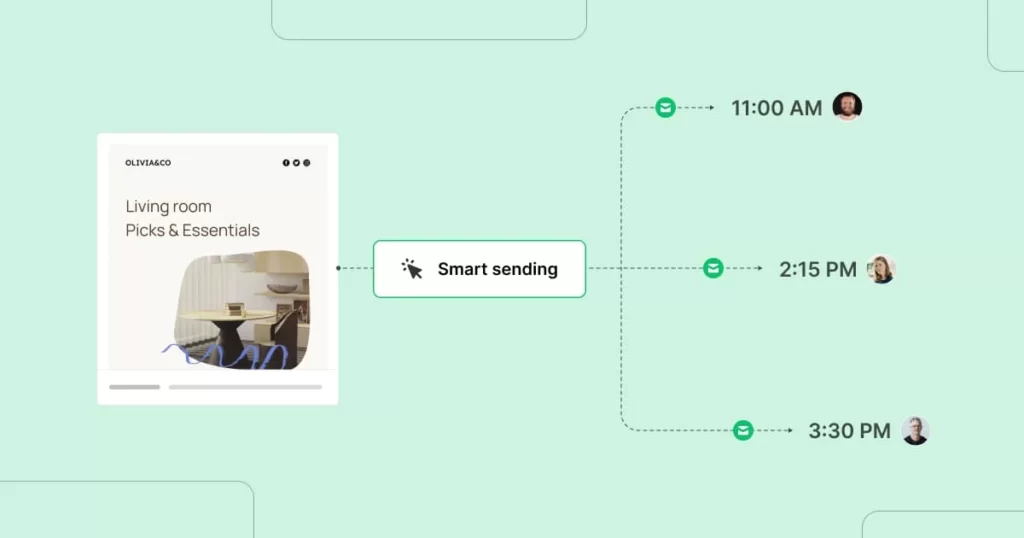
Smart sending relies on past data from opens, clicks, and signup times to figure out when subscribers are most active. The great thing is, Smart sending adjusts to how subscribers behave over time, making it more and more efficient with each use. It reduces the need for guesswork!
3. Describe the objective of the campaign🎯
Make sure you know why you’re sending each email campaign. Your email content calendar is an excellent tool to specify this and make sure your content aligns with your business objectives.
Do you aim for subscribers to connect on social media, purchase a new product, visit a webpage, or explore a new feature? Whatever goal you select, ensure it’s ‘SMART’:

Imagine we’re sending a promotional email to promote our new range of umbrellas (I’m British, so that’s the first example that came to mind!)
Our SMART goal might be:
Specific: This email aims to encourage readers to click the link and explore the new umbrella page.
Measurable: We’ll consider our goal achieved if the email click-through rate is above 10%.
Achievable: Given our high engagement rates on campaigns and social media, this is a realistic target.
Relevant:It aligns with our company objective to boost umbrella sales in 2022.
Time-based: We aim to reach this goal within one week, allowing subscribers time to open the email.
Once you choose a goal for your campaign, record it in the Goal section of your email marketing calendar.
4. Choose the group of people you want to reach. 👪
You don’t have to distribute the same newsletter to everyone on your email list. It’s more effective to divide your audience into groups and then deliver tailored campaigns to each segment.
Using the example mentioned earlier, some subscribers may reside in warmer regions and may not be concerned about umbrellas. They would likely be more interested in your sunglasses collection, warranting a different type of email. In such situations, it’s preferable to send distinct, pertinent email content to each subgroup.
When planning your email schedule, think about who your campaign is most important for. Note it in the “Target” column of your email content plan.
With MailerLite, you can sort your subscribers based on their likes, actions, and traits into segments or groups.
Segments are based on a rule that filters subscribers.
Groups can be organized by you, and subscribers are added or removed by you or through automation.
Both options help split your subscribers into groups for targeted emails.
For sending targeted content, you have two choices. You can either send different emails to each group, creating multiple campaigns, or you can make a single email and use dynamic content blocks to show different content to each group in the same email. This saves time, as you don’t need to create multiple new emails.
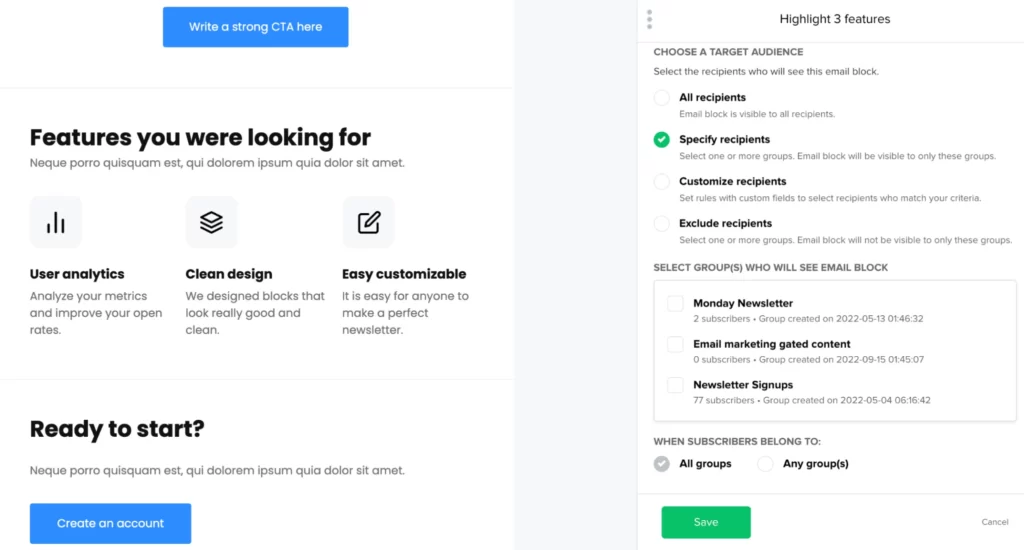
5. Find out who is responsible among the team members. 🤝
Before you send the email, it’s a good idea to have at least two people review it to ensure it meets the required standards.
To help with this, our marketing calendar includes a column where you can specify the individuals responsible for creating and reviewing the email. This ensures everyone understands their roles, preventing last-minute confusion about tasks.
When creating and reviewing the email content, take a moment to refer to our helpful guide on crafting engaging content. This will ensure your newsletter meets all the necessary criteria.
If you’re feeling a bit overwhelmed, don’t worry – we’ve got you covered with a checklist to review before hitting the ‘send’ button.
6. Get ready with the subject line and preheader. ✍
Similar to a movie trailer creating excitement for a film, your subject line and preheader provide a glimpse of what your email contains. They are the initial elements your subscribers notice in their inbox, and these initial impressions significantly influence your open rates.
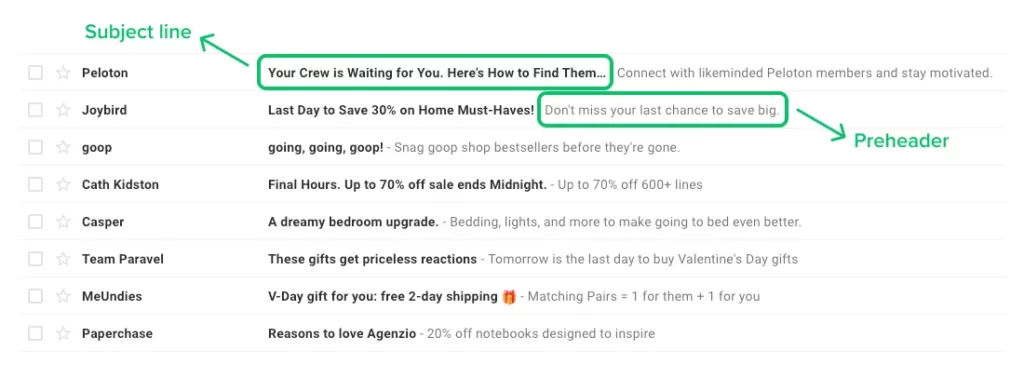
That’s why it’s useful to include your email title and preview text in your plan for content. Your coworkers can offer feedback and let you know if they’re attention-grabbing enough.
With MailerLite, you can quickly come up with several interesting email titles using the AI subject line generator. You get to choose the style and mood you want, and then the AI takes care of the rest! This not only saves time but also sparks your creativity.
To use the AI subject line generator, just make a new campaign or workflow email. When you get to the ‘Subject’ part, click on ‘Suggest.’
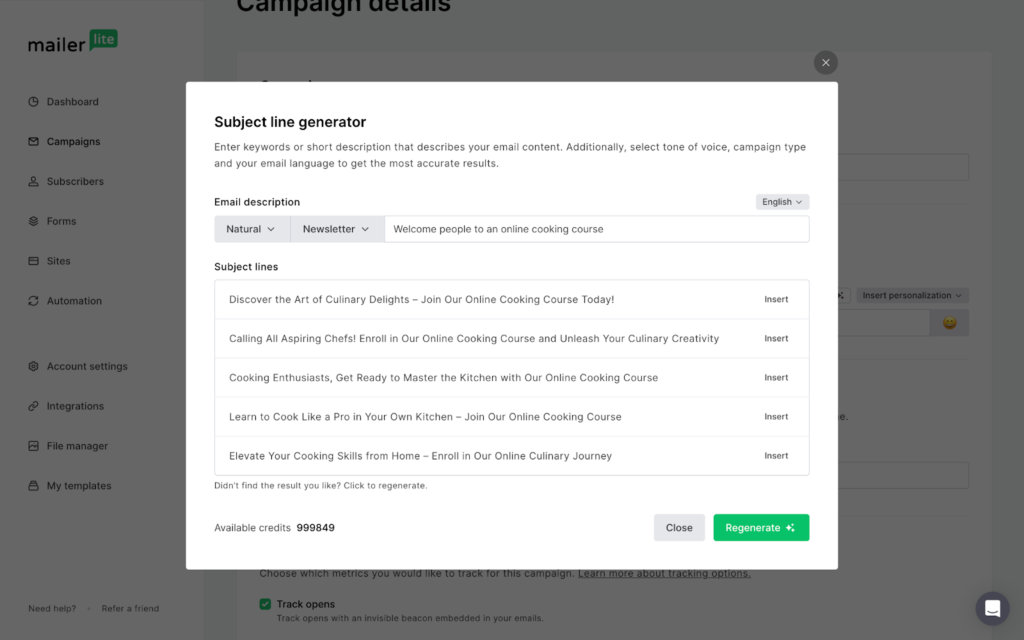
Pro tips
Before sending your email to subscribers, send a test email to yourself to check how it appears in your inbox.
Make sure to keep your subject line short, around 41 characters, so the preheader can be seen in the inbox. The aim is to craft a compelling ‘hook’ that entices people to open your email.
However, steer clear of using all capital letters, excessive exclamation points, or currency symbols, as these might cause your email to be flagged as spam.
For additional tips on creating an effective subject line, refer to the guide provided below.
7. Keep track of the project's progress. ✅
It’s helpful to monitor the project’s development by adding its status to your calendar. Our newsletter calendar template provides a dropdown menu with these options:
- Not started
- Drafting
- Reviewed
- Ready to send
- Sent
Use these options to quickly check the progress of your email marketing campaigns.
8. List any intentions for conducting multivariate testing🤓
If you plan to try out various versions of your newsletter, it’s beneficial to add this information to your content calendar. This allows you to monitor ongoing tests and share the outcomes regularly. It provides a quick summary of areas for improvement in the next campaign.
With MailerLite, we can choose between two options for variant testing:
A/B Testing: Make two versions of your newsletter and compare them by changing one thing, like the subject line or email content.
Multivariate testing (A/B/N testing): Make two versions of the identical campaign and assess up to three factors simultaneously to have greater control over your outcomes.
Every test version is initially sent to a small group of subscribers. The version that performs the best, with the highest number of opens or clicks, is then sent to the rest of your subscribers.
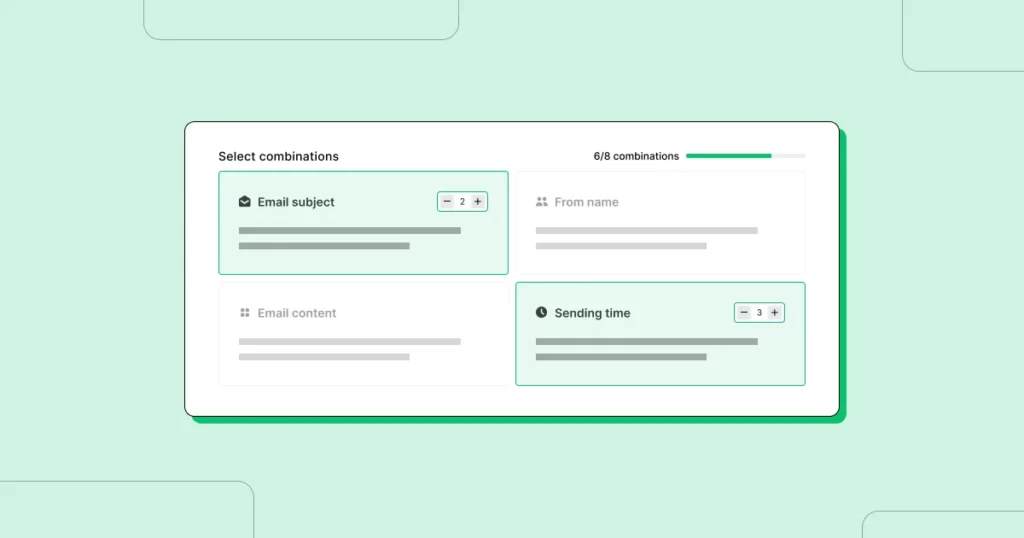
MailerLite includes a built-in A/B testing and Multivariate testing feature, allowing you to easily compare two email versions. Simply select a percentage of your audience for the test emails, and each tool automatically determines the better-performing version, sending it to the rest of your subscribers.
9. Finish the checklist to ensure the successful delivery of emails. 🛠
Before you send your email, it’s important to make sure that it has a good chance of reaching the recipients’ inboxes. Our newsletter calendar provides a checklist to help you enhance email deliverability.
The checklist includes the following sections:
| Remove subscribers who are not active. | Inactive subscribers are individuals who do not open, click, or interact with your campaigns. You can find them listed in the ‘Subscribers’ section of your MailerLite dashboard. |
| Check your email list for accuracy. | Our partners at MailerCheck can help tidy up your email list by getting rid of any generic email addresses, fixing typos, and addressing full inboxes that might lead to your newsletters bouncing. |
| Make use of Inbox Insights | MailerCheck lets you check your campaigns for potential issues like spam-like content, HTML errors, or problems with sender authentication. |
| Check where emails land in the inbox. | Before sending, check your email to ensure it doesn’t get flagged by spam filters. |
Hey, listen! 🤫
Using email marketing calendars is beneficial for organizing your email plans. If you’re looking to simplify the process of making and sending emails, you’ll appreciate MailerLite! We provide all the tools necessary for crafting email campaigns that grab attention in your subscribers’ inboxes. Click this link to discover more about our email marketing features.
10. Examine the outcomes. 📈
Great! Your newsletter has been sent, and you’re nearly finished. Before you start your next campaign, take note of the email marketing measurements you want to monitor.
In our content calendar, there are sections to keep tabs on open rates and click-through rates, as these are valuable indicators to assess a campaign’s success. By understanding the performance of various campaigns, you can enhance future emails based on what proves effective and what doesn’t.
Wondering if your metrics are on par? Since each industry is unique, we’ve put together a list of standard benchmarks for you to gauge your performance.
You can start now!
Picture a world where you never stress about what to include in your upcoming newsletter because it’s already planned out. Sounds pretty amazing, doesn’t it?
Effective email marketing campaigns are carefully organized ahead of time, and a content calendar is the ideal tool to manage everything. With an email schedule template like this, you’re on your way to a hassle-free email marketing plan and a content marketing team that’s content!


